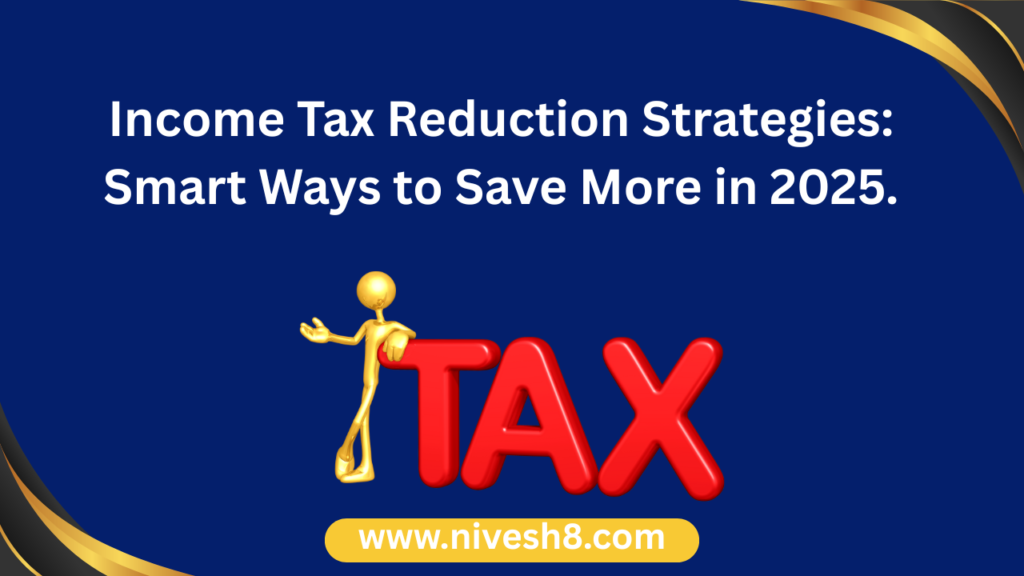Nobody wants to pay more taxes than absolutely required. Fortunately, the Indian Income Tax Act provides several legal means of lightening your tax load. These income tax reduction strategies can help you save money each year, regardless of whether you are a salaried employee, self-employed, or a business owner.
Let’s investigate the easiest, straightforward strategies to lower your income tax in India—step by step and in plain English.
1. Section 80C: Maximize the Full ₹1.5 Lakhs Limit
Under income tax reduction strategies, this is the most popular and successful approach. You may claim deductions up to ₹1.5 lakhs under Section 80C for:
- Life Insurance Premium
- Employer Provident Fund (EPF)
- Public Provident Fund (PPF)
- ELSS mutual funds (sometimes known as tax-saving funds)
- Principal return on a home loan
- Children’s tuition fees
- National Savings Certificates (NSC)
Combining these will get you the full ₹1.5 lakh limit.
2. Extra ₹50,000 under Section 80CCD(1B)
Should you be making investments in the National Pension System (NPS), Section 80CCD(1B) allows you an additional ₹50,000 deduction. This surpasses the Section 80C ₹1.5 lakh cap. While saving taxes, NPS also enables you to create a retirement corpus.
3. Section 80D: Claim Deductions for Medical Insurance
- Your own health insurance: ₹25,000; if you are a senior citizen: ₹50,000
- ₹25,000 for your parents’ health insurance; if they are senior citizens: ₹50,000
Particularly if you have elderly parents, this is one of the best income tax reduction strategies.
4. Section 24(b): Save Tax on Home Loan Interest
Should you have a home loan, Section 24(b) allows you to claim up to ₹2 lakhs deduction on annual interest paid. Depending on your loan amount and purchase date, if it is your first house, you could also get an additional ₹50,000 under Section 80EE or ₹1.5 lakh under Section 80EEA.
5. HRA (House Rent Allowance)
You could be exempt under HRA if you rent a house and get HRA from your company. Should you live on rent but lack HRA, Section 80GG allows you to claim deductions (subject to conditions).
6. Reimbursements and Tax-Free Allowances
Among the several pay elements that are either partially or totally tax-free are:
- Leave Travel Allowance (LTA)
- Food coupons, such as those from Sodexo
- Reversals of mobile and Internet bills
- Standard allowance (if applicable)
Make sure you apply for these perks and submit evidence to your company.
7. Standard Deduction for Pensioners and Salaried Individuals
Pensioners and salaried people can each claim a basic deduction of ₹50,000. It is automatic, and you are not required to provide any documentation.
8. Invest in Options for Tax-Free Income
Some income sources are completely tax-free:
- Interest earned on PPF
- Tax-free bonds like REC and NHAI
- Mutual fund dividends (limited and subject to conditions)
- Agricultural income, totally free from taxes
One of the less risky income tax reduction strategies is to use these sources.
9. Section 80E: Education Loan Interest
Under Section 80E, there is no limit, and it is valid for up to 8 years. The entire interest paid on an education loan taken out for higher studies—for yourself or your children—is deductible.
10. Section 80G: Donations to a Charity
Donations to specific NGOs, religious organizations, or relief funds allow you deductions. The company will determine whether you can claim 50% or 100% of the given donation. Verify if the NGO is qualified under 80G and gather the correct receipt.
Thought Notes: Final Thoughts
The Indian tax system offers several legal ways to lower your taxes. You can save a sizable amount of money each year by employing these income tax reduction strategies, and you can then use that money to invest, spend, or build wealth.
The secret is to keep your records ready, schedule early, and timely file your returns. If used sensibly, even little actions like rent payments, donations, or health insurance could result in large savings.
Thus, start today and keep more of your hard-earned money in your hands instead of waiting for March to rush your tax planning.

